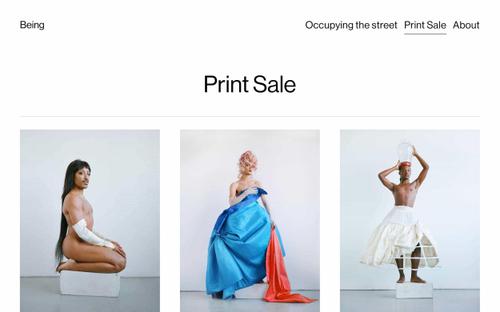Download a free workbook to help you design your site with confidence.
The email you entered is invalid.
Thank you for subscribing.
By entering your email, you indicate that you have read and understood our Privacy Policy and agree to receive marketing from Squarespace.
Webflow is a no-code website building platform that gives users visual tools to create customized websites. Webflow’s platform offers advanced design capabilities and a built-in CMS for content publishing.
However, there are many website builders to pick from, each with different features and strengths. The best choice for you depends on your skill level, design needs, and the tools you want on hand. For example, Squarespace emphasizes beautiful design and ease of use, offering an intuitive way for anyone to create a professional site. It also includes built-in features on its entry-level plans, like custom invoicing and social media syncing, to help grow a brand and online business.
Top Webflow alternatives
Squarespace
Wix
Framer
Weebly
WordPress
Shopify
Hostinger
This list includes some of the commonly cited Webflow alternatives across the web. Below you’ll find information on key criteria that might influence your decision, like ecommerce access, design flexibility, AI features, and average monthly price for annual subscriptions.
1. Squarespace
Pricing starts at: $16 per month
Squarespace is an all-in-one website building and ecommerce platform that helps anyone with an idea bring it to life online. The platform provides tools to build a beautiful, professional website, and it includes built-in features to support various types and sizes of businesses or personal websites like portfolio, resume, and wedding websites.
Squarespace vs. Webflow
Both Webflow and Squarespace offer powerful website design tools and ecommerce functionality. Webflow may be appealing to design professionals who want granular control of the site design, whereas Squarespace aims to make its website editor and all-in-one business solutions accessible for all experience levels.
Squarespace places a heavy emphasis on pairing great design with intuitive, guided tools, so you can create a polished online presence without needing developer-level skills. Webflow provides technical design flexibility and a blank-canvas approach, which can offer significant customization options but can be more complex to use.
Squarespace offers a library of predesigned templates, an AI-assisted site builder, and curated AI templates, informed by the company’s 20+ years of design expertise. Once you start a Squarespace site, you get a host of built-in features for creative control and scalability, from integrated SEO and marketing tools to ecommerce capabilities like selling unlimited products and appointment scheduling.
See our full Webflow vs. Squarespace comparison
Key features
Extensive, curated template library for websites
AI website builder and design tools
AI copy generator and SEO features
Ecommerce (online stores, shipping labels, invoicing, native payments, and more)
Appointment scheduling with Acuity Scheduling
Email and social media marketing tools
Robust third-party extension options
Native payments with Squarespace Payments
Pros of Squarespace
All-in-one platform
Flexible design customization options
Ease of use
Affordable subscription plans
24/7 customer support
Squarespace plans
Basic: Website design and hosting, free domain, and tools for ecommerce, invoicing, and taking payments
Core: All Basic features plus lower fees, more advanced analytics, custom code, and shipping and tax tools
Plus: All Core features with lower fees on digital content and memberships
Advanced: All Plus features with the lowest fees and full selling functionality
Note: Plans and pricing for each platform can vary by location. For Squarespace, see our pricing page for the most up-to-date details in your location.
2. Wix
Pricing starts at: $17 per month or limited free plan
Wix is a website builder designed to make creating a website accessible to everyday users. It features a drag-and-drop editor and a wide selection of templates, along with an AI website generator and a large app marketplace.
Wix vs. Webflow
Wix and Webflow both let users create and customize websites visually, but their approach differs. Wix is generally considered more beginner-friendly, while Webflow offers more advanced design flexibility for those with web development experience. Webflow separates its features across several plan types, while Wix includes broader functionality across fewer plans. Both platforms offer ecommerce, but you’ll need to upgrade to higher-tier plans to access selling tools.
Key features
Drag-and-drop website editor
AI website builder
App market for added features
Ecommerce tools on higher-tier plans
Limited free plan available
3. Framer
Pricing starts at: $5 per month
Framer is a no-code website builder with a strong focus on design and collaboration. It includes AI generation tools, responsive design, and the ability to customize with custom code.
Framer vs. Webflow
Framer and Webflow are both aimed at design flexibility, but Framer places additional emphasis on real-time collaboration and design simplicity. Webflow includes some more built-in functionality on its plans, though Framer offers plugins to add features. For example, Framer does not currently offer native ecommerce features, while Webflow does on its ecommerce-specific plans.
Key features
Real-time design collaboration
AI website generator
Custom code support
CMS and SEO tools
See our full Framer vs. Squarespace comparison
4. Weebly
Pricing starts at: $10 per month or limited free plan
Weebly is an ecommerce-focused website builder from Square. It offers simple website templates, drag-and-drop editing, and ecommerce features on all plan tiers, including the free plan.
Weebly vs. Webflow
Because of its ecommerce focus, Weebly offers access to online selling tools from the start. Webflow offers more advanced website customization features. Because it’s owned by Square, Weebly integrates directly with Square for payments and in-person point-of-sale (POS), while Webflow requires third-party tools for similar functionality. Webflow requires higher-tier plans to access ecommerce features.
Key features
Drag-and-drop website editor
Ecommerce on all plans
Square POS integration
Mobile app for site management
See our full Weebly vs. Squarespace comparison
5. WordPress
Pricing starts at: $4 per month or limited free plan
WordPress.com is a website builder built on the open-source WordPress CMS. It allows users to build websites with themes and plugins and includes blogging tools and content management capabilities.
WordPress vs. Webflow
WordPress offers flexibility through themes and plugins, while Webflow provides a website design platform with built-in website hosting. Because many features come from plugins, WordPress may require more manual setup, but both may require some technical or design expertise, especially for advanced customization or ecommerce. Both platforms offer ecommerce, but you’ll need to upgrade to higher-tier plans to use selling features.
Key features
Theme library
Plugin-based customization
Built-in blogging tools
Ecommerce via plugins on higher-tier plans
See our full WordPress.com vs. Squarespace comparison
6. Shopify
Pricing starts at: $29 per month
Shopify is a website builder designed for ecommerce. It includes a storefront, product catalog tools, built-in payment processing, and shipping integrations on its entry-level plan.
Shopify vs. Webflow
Shopify is focused on online selling, particularly of physical products, and includes many ecommerce tools by default. Webflow also supports ecommerce, but those features are only available on higher-tier plans. However, Webflow’s lowest-priced ecommerce plan is priced similarly to Shopify’s, so it’s worth comparing features if ecommerce is a must-have.
Key features
Ecommerce features on all plans
Customizable themes
Integrated payments and shipping tools
App Store for extended functionality
Multichannel selling support
See our full Shopify vs. Squarespace comparison
7. Hostinger
Pricing starts at: $3.99 per month
Hostinger is a web hosting provider that offers a bundled website builder. It includes AI tools, basic ecommerce capabilities, and drag-and-drop editing.
Hostinger vs. Webflow
Hostinger’s website builder is simpler and may be considered more limited in design control compared to Webflow. It includes ecommerce and additional AI features on higher-tier plans. Webflow offers more custom design features, but it may be a more advanced platform to learn for those with less design experience.
Key features
AI website builder and content tools
Drag-and-drop editor
Ecommerce on higher-tier plan
Basic SEO and marketing integrations
See our full Hostinger vs. Squarespace comparison
How to choose a website builder
The website building platform you use depends on your goals, budget, and preferences. Consider what matters most to you: price, ease of use, design flexibility, ecommerce features, or growth potential. Every platform has its own mix of tools and tradeoffs.
Evaluate the features offered by each platform and subscription plan and compare website designs too. Ask yourself which platform:
Matches your design aesthetic
Feels straightforward to update and maintain
Includes the features you need now and in the future
Can simplify your workflow by consolidating your tools
If you’re planning to switch from Webflow or another platform, think about what you need most going forward, whether that’s a simpler setup, more built-in features, or advanced design options. Also consider how easy it is to move your content and domain. Choosing a platform that simplifies the migration process can make the switch faster and smoother.



